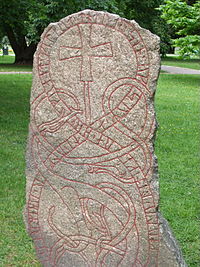- Uppland Runic Inscription 489
-
Runestone 
Name Uppland Runic Inscription 489 Rundata ID U 489 Country Sweden Region Uppland City/Village Uppsala University, Uppsala Produced eleventh century Runemaster Öpir
Text - NativeOld Norse :
Gullaug(?) let gæra bro fyr and GillaugaR, dottur sinnaR ok sum atti UlfR. ØpiR risti.[1]Text - English Gullaug(?) had the bridge made for the spirit of Gillaug, her daughter, and whom Ulfr owned (i.e. was married to). Öpir carved.[1] Other resources Runestones - Runic alphabet
Runology - Runestone stylesThis Viking Age runestone, listed under Rundata as runic inscription U 489, was originally located in Morby, Uppland, Sweden, and is a memorial to a woman.
Description
This runestone was shipped together with two other runestones, runic inscriptions U 896 and U 1011, to the Exposition Universelle in Paris in 1867. Today it is located at Uppsala University at the Universitetsparken (University Park).
The reference to bridge-building in the runic text is fairly common in rune stones during this time period. Some are Christian references related to passing the bridge into the afterlife. At this time, the Catholic Church sponsored the building of roads and bridges through the use of indulgences in return for intercession for the soul.[2] There are over one hundred examples of bridge runestones that have been dated from the eleventh century, including inscriptions Sö 101 in Ramsund, Sö 328 in Tynäs, U 617 in Bro,[2] U 861 in Norsta, and U 993 in Brunnby. On this runestone, the Christian message is reinforced by the image of the cross within the serpent text band.[3]
It is unusual for a memorial runestone to be dedicated to a woman, and even more unusual for a memorial to a woman be sponsored by a woman. A survey indicated that less than 1 per cent of all runestones fall into this later category.[4] The husband of Gillaug is not mentioned in the inscription as a sponsor of the stone. This could be because Ulfr was dead at the time of the carving of this memorial for his wife.
This runestone is signed by the runemaster Öpir, who was active in the late 11th and early 12th centuries. It is classified as being carved in runestone style Pr4, also known as late Urnes style. This runestone style is characterized by slim and stylized animals that are interwoven into tight patterns. The animal heads are typically seen in profile with slender almond-shaped eyes and upwardly curled appendages on the noses and the necks.
Transliteration
A transliteration of the runic text is:
- khulu ' lit ' kira ' bro fr ant ' kilaua ' totur ' sin ' uk sum ' ati ' ulfr ' ybiR risti[1]
References
- ^ a b c Project Samnordisk Runtextdatabas Svensk - Rundata entry for U 489.
- ^ a b Gräslund, Anne-Sofie (2003). "The Role of Scandinavian Women in Christianisation: The Neglected Evidence". In Carver, Martin. The Cross Goes North: Processes of Conversion in Northern Europe, AD 300-1300. Boydell Press. pp. 490–492. ISBN 1-903153-11-5. http://books.google.com/books?id=4YKrpH222eYC&printsec=frontcover&source=gbs_navlinks_s#v=onepage&q=&f=false.
- ^ Bertelsen, Lise Gjedssø (2006). "On Öpir's Pictures". In Stoklund, Marie; Nielsen, Michael Lerche et al. Runes and Their Secrets: Studies in Runology. Copenhagen: Museum Tusculanum Press. p. 39. ISBN 87-635-0428-6. http://books.google.com/books?id=USIpSluLe10C&printsec=frontcover&source=gbs_navlinks_s#v=onepage&q=&f=false.
- ^ Sawyer, Birgit (2000). The Viking-Age Rune-Stones: Custom and Commemoration in Early Medieval Scandinavia. Oxford University Press. p. 40. ISBN 0-19-820643-7. http://books.google.com/books?id=4M4-r-VL_WkC&printsec=frontcover&source=gbs_navlinks_s#v=onepage&q=&f=false.
Categories:- Runestones raised in memory of women
- Runestones in Uppland
Wikimedia Foundation. 2010.
